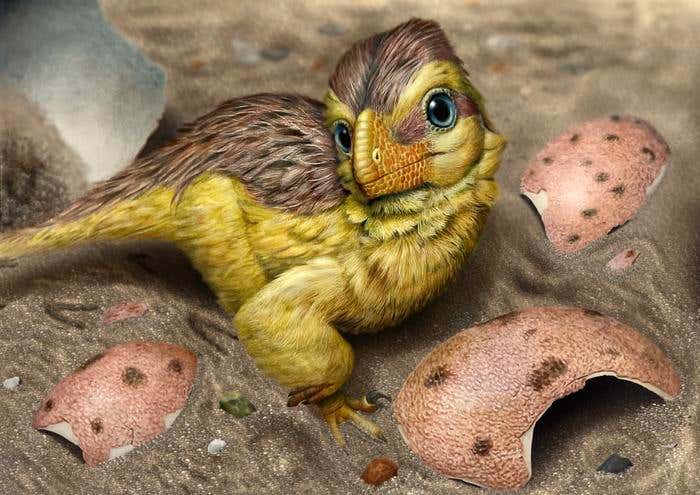Dinosaur eggshells are accurate timekeepers of fossil age, study finds
Scientists can now use fossil dinosaur eggshell as a uranium lead clock, sharply improving age dates for hard to time fossil sites.

 Edited By: Joseph Shavit
Edited By: Joseph Shavit

An international team has shown that fossil dinosaur eggshell can be dated with uranium lead methods, delivering precise ages for rock layers that lack volcanic ash and opening a new window on when dinosaurs and their ecosystems really lived. (CREDIT: Eva Utsukiyouhei (宇津城遥平))
Layers of rock can tell the story of life on Earth, but only if you know when each chapter was written. For many dinosaur sites, that date has been little more than a rough guess. Now, a team of researchers has shown that the answer can be locked inside something surprisingly fragile: fossilized dinosaur eggshell.
Why Dating Dinosaur Fossils is So Hard
Paleontologists often work with rock layers that are only loosely dated. That makes it hard to tell whether two dinosaur species lived together, followed each other, or were separated by millions of years. Without firm ages, it is tough to track how ecosystems changed or how quickly animals evolved and vanished.
Usually, scientists look for volcanic ash near fossils. Tiny zircon or apatite crystals inside that ash can be dated very precisely using uranium and lead. The problem is that many famous fossil beds do not have any volcanic layers at all. In those places, ages are based on broad comparisons rather than solid numbers.
Trying to date the fossils themselves has not solved the problem. Bones and teeth often exchange elements with groundwater long after burial. That chemical overprint can scramble the radioactive clock and produce ages that do not match reality.
Turning Eggshells Into Natural Clocks
Dr. Ryan Tucker, a geologist at Stellenbosch University, and an international team decided to tackle the problem from a different angle. Instead of dating the rock around fossils, they went after the eggs that once sheltered dinosaur embryos. Their results, published in Communications Earth & Environment, show that eggshell can act as a tiny but reliable timekeeper.
Fossil dinosaur eggshell is made mostly of calcite, a crystalline form of calcium carbonate. When an egg is buried, trace amounts of uranium can slip into that calcite. Over tens of millions of years, uranium atoms slowly decay into lead at a known rate. By measuring the ratio of uranium to lead, scientists can calculate when the eggshell was sealed by burial.
Dr. Tucker and his colleagues used high precision uranium lead dating and detailed elemental maps to track where uranium and lead sit inside the calcite. That mapping is crucial. If those elements have moved around, the clock is broken. If they remain locked in the original crystal structure, the age should be trustworthy.
“Eggshell calcite is remarkably versatile,” Tucker said. “It gives us a new way to date fossil sites where volcanic layers are missing, a challenge that has limited paleontology for decades.”
Testing the Method in Utah and Mongolia
To see if the method worked, the team first turned to dinosaur eggshell from Utah in the United States. The eggs came from a rock formation that also contains volcanic ash with well known ages. That made it a perfect test case.
Using laser ablation and mass spectrometry, the researchers sampled hundreds of tiny spots on the Utah eggshells. Uranium levels were low but measurable. When they combined the data, the eggshell age landed within about five percent of the precise ash bed dates, around the mid Cretaceous, roughly 95 million years ago. For deep time, that is a tight match.
The team then pushed the method into more uncertain territory. They collected eggshells from the Gobi Desert of Mongolia, along a 3.5 kilometer stretch of rock that holds dinosaur nests and eggs. This historic locality, studied for decades, had never been directly dated because it lacks volcanic layers.
Fieldwork there was carried out through the Mongolian Alliance for Dinosaur Exploration and involved scientists from the Mongolian Academy of Sciences and several North and South American institutions. Back in the lab, the eggshells from Mongolia passed every preservation test. Their calcite layers were crisp and continuous. Element maps showed that uranium and other trace elements followed original growth bands rather than later cracks.
When the team ran the uranium lead analyses, the results were strikingly consistent. Eight eggshells from four linked sites all pointed to an age of about 75 million years. For the first time, that famous nesting horizon now has a direct numerical age instead of a broad guess.
What Eggshells Reveal About Deep Time
By proving that dinosaur eggshell can hold a clean radioactive clock, the study gives paleontologists a new way to anchor entire fossil communities in time. The eggs might belong to one species, but the age they record applies to everything buried in the same layer, from plants and invertebrates to other dinosaurs and early mammals.
“Direct dating of fossils is a paleontologist’s dream,” said study co author Lindsay Zanno of North Carolina State University and the North Carolina Museum of Natural Sciences. “Armed with this new technique, we can unravel mysteries about dinosaur evolution that used to be insurmountable.”
Because calcified eggs have existed for more than 250 million years, this method is not limited to one group. Birds, reptiles and many extinct lineages all left eggshell behind. That means the same approach could help date fossil sites across several geologic periods and continents.
Just as important, the work ties biology and Earth science together in a fresh way. An object that once protected a growing embryo now doubles as a geologic record of when that life took place. It is a rare case where the fossil itself and the rock clock are one and the same.
Limits and Challenges
The new method does not apply to every egg in the fossil record. It depends on excellent preservation. If groundwater dissolves parts of the shell or fills it with new minerals, uranium and lead can shift, and the age will no longer reflect the original burial time.
To avoid that trap, the team built a careful screening process. They studied eggshell slices under microscopes, looked for clean crystal patterns and used chemical maps to flag any altered zones. Only shells that passed those tests were dated. The authors also stress that, whenever possible, eggshell ages should be checked against other evidence, such as magnetostratigraphy or any nearby datable minerals.
Future work will test eggshell from different species, climates and ages to see how often the clock stays closed. If the method proves robust in a wider range of settings, it could become a standard tool for dating sedimentary basins that lack volcanic ash.
For paleontologists, this research offers something close to a superpower. Being able to date dinosaur eggshell directly means that many fossil sites, once stuck with broad age ranges, can now be pinned to specific windows in time. That sharper timing will help researchers ask new questions about how fast dinosaurs evolved, how quickly they responded to climate shifts and how ecosystems changed leading up to major extinctions.
Next Steps
Beyond dinosaurs, the method could be adapted to other fossil eggs and possibly to some calcite rich fossils from different animals. That would expand the set of tools scientists use to build timelines of life on Earth, especially in regions where volcanic ash and traditional dating minerals are rare or absent.
For the broader public, the work promises more accurate museum labels, clearer family trees in popular science books and a better sense of when favorite species actually walked the planet. Over the long term, it may also sharpen models that compare past climate events to current warming by tying fossil records more firmly to the geologic timescale.
As more teams adopt and refine this eggshell dating approach, the scattered pages of Earth’s story may start to snap into a clearer sequence. In that future, a single cracked shell in a desert outcrop could unlock the age of an entire ancient world.
Research findings are available online in the journal Nature Communications.
Related Stories
- Incredible bonebed discovery finds large dinosaur fossils nearly stacked on top of each other
- Scientists discover first-ever hooved dinosaur in Wyoming’s ‘Mummy Zone’
- Dinosaurs thrived until the end: New Mexico fossils rewrite extinction story
Like these kind of feel good stories? Get The Brighter Side of News' newsletter.
Mac Oliveau
Science & Technology Writer
Mac Oliveau is a Los Angeles–based science and technology journalist for The Brighter Side of News, an online publication focused on uplifting, transformative stories from around the globe. Passionate about spotlighting groundbreaking discoveries and innovations, Mac covers a broad spectrum of topics—from medical breakthroughs and artificial intelligence to green tech and archeology. With a talent for making complex science clear and compelling, they connect readers to the advancements shaping a brighter, more hopeful future.



